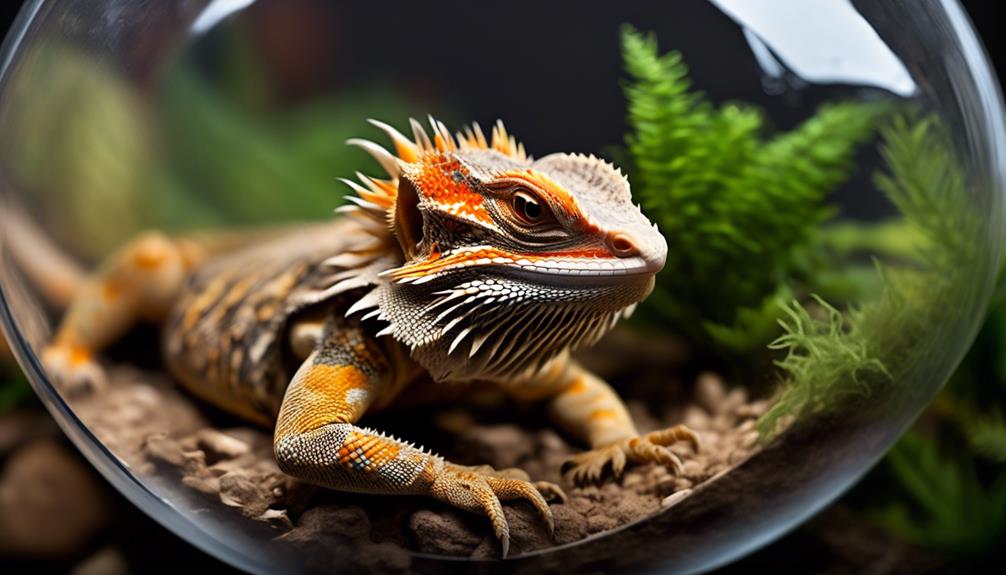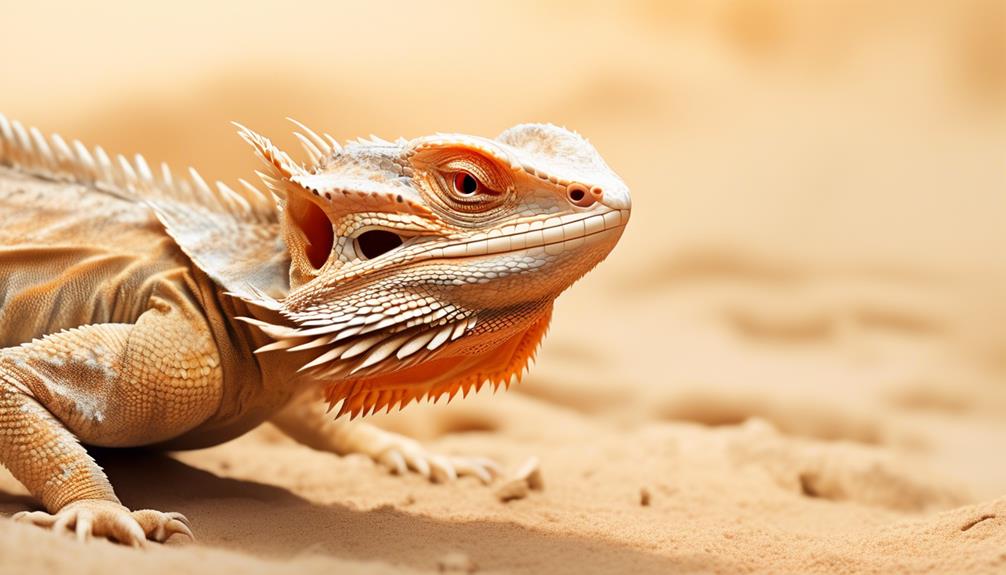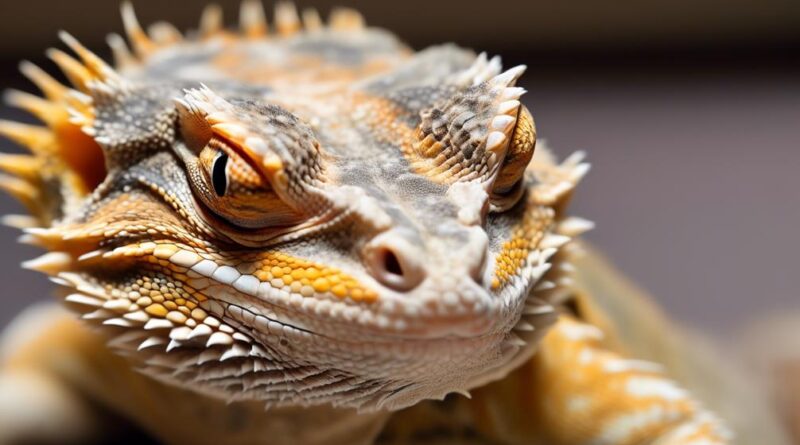10 Telltale Signs of Stress in Bearded Dragons
You may not realize that bearded dragons, like humans, can experience stress. Understanding the signs of stress in these reptiles is crucial for their well-being.
If you've noticed changes in your bearded dragon's behavior or appearance, it could be a sign that they are under stress. From alterations in coloration to unusual vocalizations, there are several indicators to watch out for.
By being able to recognize these signs, you can take the necessary steps to address your bearded dragon's stress and ensure they remain healthy and content.
Changes in Coloration
Have you noticed your bearded dragon's color becoming dull or faded? This could be a sign of stress. Bearded dragons are ectothermic creatures, meaning they rely on external sources of heat to regulate their body temperature. Environmental factors such as inadequate temperature regulation in their habitat can cause stress, which in turn affects their coloration. To address this, it's crucial to ensure that the temperature and lighting in their enclosure mimic their natural habitat. Using a thermometer and heat lamps can help maintain the optimal temperature range for your bearded dragon, reducing the likelihood of stress-related color changes.
Stress relief techniques and environmental enrichment are vital for promoting a healthy and content bearded dragon. Providing them with a spacious and stimulating environment can help alleviate stress. Incorporating hiding spots, climbing branches, and basking areas within their enclosure can offer mental and physical stimulation. Additionally, offering a varied diet, including live insects and vegetables, can contribute to their overall well-being and reduce stress levels. Creating a consistent daily routine and minimizing sudden environmental changes can also help manage stress.
Loss of Appetite
If your bearded dragon is displaying a sudden loss of appetite, it may indicate underlying stress or health issues. Behavioral changes such as refusing to eat or reduced interest in food can be a cause for concern. Loss of appetite is a common sign of stress in bearded dragons and can also be indicative of various health concerns.
When a bearded dragon experiences stress, whether from changes in their environment, improper handling, or other factors, they may exhibit a decrease in appetite. Additionally, health issues such as gastrointestinal problems, dental pain, or internal parasites can also lead to a loss of appetite in bearded dragons. It's important to monitor your pet for any consistent changes in eating habits and consult a reptile veterinarian if necessary.
It's crucial to address the underlying cause of the loss of appetite to ensure the overall well-being of your bearded dragon. Providing a comfortable and secure habitat, minimizing handling stress, and maintaining proper temperature and lighting in their enclosure can help reduce behavioral stress. Regular veterinary check-ups and a balanced diet can also contribute to preventing health-related appetite issues.
Excessive Hiding
Excessive hiding behavior in bearded dragons may indicate underlying stress or discomfort, and it's important to monitor and address this behavior promptly. Bearded dragons are known to exhibit certain coping strategies in response to stress, and excessive hiding is one of the telltale signs. As a responsible dragon owner, it's crucial to be vigilant and observant of any behavioral changes in your pet.
When you notice your bearded dragon excessively hiding, it's essential to consider environmental adjustments and stress management. Assess the enclosure to ensure that it provides the necessary temperature gradients, hiding spots, and proper lighting. An inadequate or overly stimulating environment can contribute to stress in bearded dragons, leading to excessive hiding behavior. Additionally, evaluate the placement of the enclosure to minimize potential stressors such as loud noises or excessive foot traffic.
To address excessive hiding, consider implementing behavioral changes and coping strategies. Spend quality time with your bearded dragon to build trust and reduce stress. Providing enrichment activities, such as introducing new textures or rearranging the enclosure, can also help alleviate stress and encourage natural behaviors. Furthermore, maintain a consistent daily routine to promote a sense of security and stability for your pet.
Aggressive Behavior
After addressing excessive hiding in your bearded dragon, it's essential to recognize and understand the potential triggers and management of aggressive behavior. Aggression in bearded dragons can be caused by various factors, including stress, improper handling, and lack of environmental enrichment.
Here are some key points to consider when dealing with aggressive behavior in your bearded dragon:
- Handling techniques: Be mindful of your approach when interacting with your bearded dragon. Avoid sudden movements and always support their body properly to make them feel secure. Gradually introduce handling to build trust and reduce the likelihood of aggressive responses.
- Environmental enrichment: Ensure that your bearded dragon's enclosure provides enough mental and physical stimulation. This includes providing hiding spots, climbing structures, and varied textures to explore. Environmental enrichment can help reduce stress and prevent aggressive behavior.
- Observation and understanding: Observe your bearded dragon's body language and behavior to identify potential triggers for aggression. Understanding what causes stress or discomfort can help you avoid such situations and minimize aggressive responses.
- Consistency and routine: Establishing a consistent routine for feeding, handling, and environmental changes can help reduce stress and anxiety in your bearded dragon, thereby reducing the likelihood of aggressive behavior.
- Seeking professional help: If your bearded dragon's aggressive behavior persists despite your efforts, seeking guidance from a reptile veterinarian or experienced reptile keeper can provide valuable insights and support in managing the aggression effectively.
Pacing or Restlessness

To identify pacing or restlessness in your bearded dragon, observe their behavior for frequent and repetitive movements around the enclosure. Bearded dragons may display pacing or restlessness when they're in need of environmental enrichment or when their behavioral patterns are disrupted. If you notice your bearded dragon constantly moving back and forth or attempting to climb the walls of their enclosure, it could be a sign of distress.
Environmental enrichment plays a crucial role in keeping your bearded dragon mentally stimulated and engaged. Lack of stimulation can lead to pacing or restlessness as your pet seeks ways to alleviate their boredom. To address this, ensure that your dragon's enclosure provides a variety of items such as branches, rocks, and hides for exploration and physical activity. Additionally, incorporating different textures and substrates can also promote natural behaviors and reduce restlessness.
Monitoring your bearded dragon's behavioral patterns is essential in identifying pacing or restlessness. Pay attention to any changes in their routine or habits, as disruptions to their usual activities can cause stress and restlessness. Factors such as changes in their environment, diet, or social interactions can all contribute to this behavior. By closely observing your bearded dragon, you can better understand their needs and make adjustments to their care to alleviate pacing or restlessness.
Abnormal Posture
If your bearded dragon displays an unusual posture, such as arching its back or holding its limbs in an abnormal position, it could be an indication of discomfort or potential health issues. Abnormal posture in bearded dragons is often a sign that something is amiss and should be carefully observed. Here are some key points to consider:
- Behavioral changes: Abnormal posture is often accompanied by other behavioral changes such as lethargy, decreased appetite, or increased aggression. These behavioral changes can be indicative of stress or discomfort in your bearded dragon.
- Physical indicators: When assessing abnormal posture, it's important to look for physical indicators such as swelling, redness, or tenderness in specific areas of the body. These physical indicators can be stress symptoms that need to be addressed promptly.
- Veterinary assessment: If you notice your bearded dragon consistently displaying abnormal posture, it's crucial to seek a veterinary assessment. A veterinarian specializing in reptiles can conduct a thorough examination to identify any underlying health issues contributing to the abnormal posture.
- Environmental factors: Evaluate the environmental conditions in your bearded dragon's habitat. Inadequate temperature, lighting, or humidity levels can lead to stress and discomfort, which may manifest as abnormal posture.
- Handling and interactions: Consider recent handling and interactions with your bearded dragon. Improper handling or stressful interactions with other pets can contribute to abnormal posture and overall stress levels in your bearded dragon.
Breathing Irregularities

Noticing irregularities in your bearded dragon's breathing, such as labored or shallow breaths, can be another indication of potential stress or health issues, building upon the signs of discomfort or health concerns identified through abnormal posture. Labored breathing, which is characterized by visible effort or strain during breathing, can be a sign of respiratory distress in bearded dragons.
If you observe your dragon panting or breathing heavily without an apparent cause, it may be experiencing difficulty breathing, which warrants immediate attention.
Respiratory infections are a common cause of breathing irregularities in bearded dragons. These infections can lead to symptoms such as wheezing, open-mouth breathing, or gasping for air. Additionally, stress can weaken a bearded dragon's immune system, making it more susceptible to respiratory issues. If you notice any of these signs, it's crucial to seek veterinary care promptly to prevent the infection from worsening.
Furthermore, environmental factors such as inadequate humidity levels or poor air quality within the enclosure can also contribute to breathing difficulties in bearded dragons. Ensure that the terrarium is well-ventilated and that humidity levels are appropriate for your dragon's needs.
Unusual Vocalizations
You may observe your bearded dragon making unusual vocalizations, which can be a sign of stress or discomfort. Bearded dragons are generally quiet pets, so any vocalization patterns that deviate from their usual behavior may indicate underlying issues.
Here are some key points to consider regarding unusual vocalizations in bearded dragons:
- Hissing or Puffing: If your bearded dragon starts hissing or puffing, it could be a response to stress triggers such as feeling threatened or being in an unfamiliar environment.
- Whimpering or Whining Sounds: Unusual whimpers or whines may indicate discomfort or pain in your bearded dragon. It's important to observe their behavior closely and seek veterinary attention if these vocalizations persist.
- Loud, Continuous Vocalizations: Bearded dragons may emit loud, continuous vocalizations when they're feeling distressed or agitated. This could be a sign of being housed in an unsuitable environment or experiencing stress triggers such as excessive handling.
- Chirping or Clicking Noises: Some bearded dragons may make chirping or clicking noises that can signal distress or a response to perceived threats. It's crucial to identify the source of these stress triggers and address them promptly.
- Silent or Weak Vocalizations: In some cases, bearded dragons may become silent or produce weak vocalizations when they're experiencing stress, illness, or discomfort. Monitoring their vocalization patterns can provide valuable insights into their well-being.
Understanding your bearded dragon's vocalization patterns and identifying potential stress triggers can help you create a comfortable and stress-free environment for your pet.
Frequently Asked Questions
Can Stress in Bearded Dragons Lead to Long-Term Health Issues?
Stress in bearded dragons can indeed lead to long-term health issues. Proper stress management is key to preventing these effects. Make sure to create a calm and comfortable environment for your dragon to minimize stress.
How Can I Help My Bearded Dragon Feel Less Stressed in Their Environment?
To help your bearded dragon feel less stressed in their environment, focus on creating a stress-free habitat with proper temperature, lighting, and hiding spots. Provide behavioral enrichment like climbing branches and interactive toys to promote mental stimulation and reduce stress.
Are There Any Specific Signs of Stress That Are Unique to Certain Breeds or Individuals?
When it comes to specific breeds, stress indicators can vary. Some individuals may show unique stress behaviors. Proper stress management and behavioral modifications tailored to your dragon's breed and individual needs can help alleviate stress.
Can Stress in Bearded Dragons Be Caused by Changes in Their Diet or Habitat?
Behavioral changes in bearded dragons can be caused by environmental adjustments like diet or habitat changes. These alterations may lead to stress, affecting their health and behavior. It's important to monitor and address these changes promptly.
Are There Any Natural Remedies or Supplements That Can Help Reduce Stress in Bearded Dragons?
If your bearded dragon is stressed, natural remedies like creating a calm environment, providing adequate lighting and temperature, and offering a balanced diet can help reduce stress. Consider supplements and behavioral changes for stress reduction.
Conclusion
In conclusion, keeping an eye out for these 10 telltale signs of stress in bearded dragons can help you identify and address any potential issues with your pet's well-being.
By recognizing these symptoms early on, you can take the necessary steps to reduce their stress and ensure they lead a happy and healthy life.
Remember to always consult with a veterinarian if you have any concerns about your bearded dragon's behavior.
